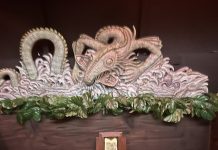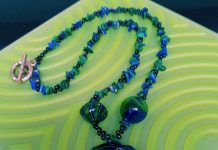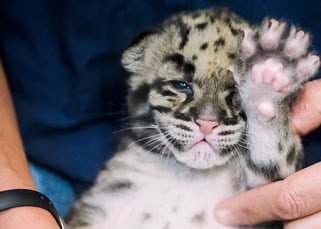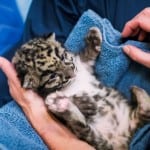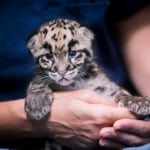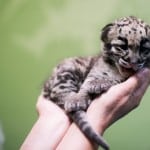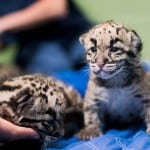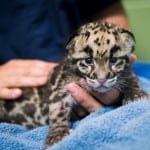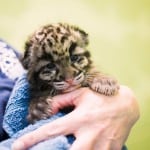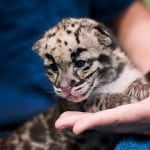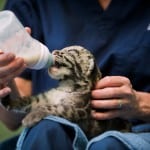Submitted by Point Defiance Zoo and Aquarium
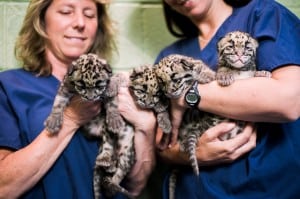
Zookeepers have selected names for Point Defiance Zoo and Aquarium’s one-month old clouded leopard quadruplets. They are Orchid, Banyan, Kapok (pronounced kay-pok) and Teak.
There are three males and one female in the unusually large litter, and each of these fauna will be named for flora that can be found in clouded leopards’ native Southeast Asia.
But while zookeepers have settled on names for the cubs, it could take a bit of time before they decide which one fits each of the three boys in the litter best. The girl is easy. She’s Orchid.
The cubs, born May 12 to mother Chai Li (pronounced Chai-lye), are healthy and thriving. Their father is Nah Fun (pronounced Nah Foon).
They are being hand-raised by zookeepers, who care for them around the clock. Their diet of a milk
formula for cats is supplemented by a bit of baby cereal with rice, said Staff Biologist Andy Goldfarb, who has worked with exotic cats for more than three decades and is a world-recognized expert in clouded leopard cubs.
The cubs weighed around a half-pound at birth. Now, each is in the 2.5-pound range. At just three weeks, a cub could fit snugly in the palm of Goldfarb’s hand. Now, each is more than a handful. And their canines have erupted, so keepers must take care around their growing, razor-sharp teeth.
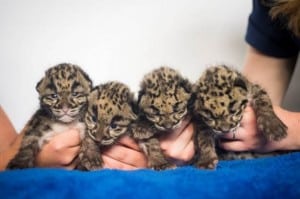
Their steel-blue eyes have been open for a couple of weeks now, and the little guys are more mobile, somewhat aimlessly meandering around their den on fast little legs, walking into and crawling over obstacles like stuffed animals that are bigger than they are.
As they move around more, their personalities are emerging, too.
Orchid is so eager to eat she emits squeaking sounds, and her tiny paws are in constant motion trying to grab her feeding bottle before a keeper can get it to her. She’s so excited to get her food, she immediately chomps down on the nipple of the bottle and then appears frustrated that she isn’t getting any milk. With the help of a keeper, she finally starts sucking on the nipple, slows down and drinks at a not-too-fast pace.
The three males each have some distinctions. The last cub born, who was one of the smallest at first, is now one of the largest. “He’s one of the most chilled out, relaxed, easy-going cubs,” Goldfarb said. “When he’s eating, he really looks up at you and pays attention.”
Goldfarb describes another one of the males as “pretty mellow,” but the growing cat doesn’t waste any time getting through his breakfast. He drains his milk bottle in a flash and then squirms to get down off the keeper’s lap so he can go exploring. And, he’s quickly off and running as fast as his little legs will take him, checking out the stuffed tiger toys in the Cub Den, trying to squirm behind Goldfarb (where he’s not allowed to go) and then suddenly stopping to take care of his post-meal bodily functions.
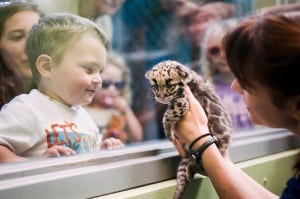
The third male’s face appears furrowed as he impatiently waits for his warm bottle.
Goldfarb couldn’t give a date, but he thinks it won’t be too long before feeding time gives way to longer play times for the cubs and all four will get to roam and play for longer periods in the Cub Den.
Zookeepers smile broadly when they see crowds of visitors, noses pressed against the Cub Den windows, looking in for a view of these rare and endangered animals.
“A lot of work must be done to protect clouded leopards in the wild,” Goldfarb said, pointing out that these cubs serve as first-line ambassadors for their wild counterparts. “Most people don’t even know what they are,” he added of the elusive cats that live in the forests of Southeast Asia. “They are incredible cats.”
But clouded leopards are facing increasing pressure from poachers and habitat destruction in their native ranges. The animals are so reclusive and difficult to spot in the wild, it’s not known how many of them remain.
There are just under 100 clouded leopards in 25 North American zoos that participate in the Clouded Leopard Species Survival Plan.® Fifteen cubs have been born through the program this year.
Counting the quadruplet cubs, 11 clouded leopards live at Point Defiance Zoo and Aquarium.
People who are inspired by the clouded leopards’ story and want to contribute to conservation programs on their behalf may donate to the Dr. Holly Reed Wildlife Conservation Fund through the donation kiosk at the Cats of the Canopy exhibit on zoo grounds or through The Zoo Society at www.pdza.org/donate.
More information is available at http://www.pdza.org/clouded-leopard-cubs.
The zoo is open daily from 9:30 a.m. to 6:00 p.m. For a sneak peek at the clouded cuties, scroll through the slideshow below.














